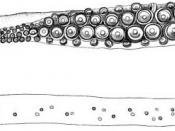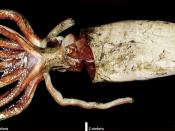Size: Architeuthidae can grow up to 60 feet in total length, and weigh between 1000 lbs and a tone. The Genus Architeuthidae are the largest known cephalopods, the largest known mollusks and the largest invertebrates ever known to exist in the ocean.
Habitat: A giant squid lives between 200 and 1000 meters in depth, close to the bottom of the sea, around large underground canyons. They must live in deep water because the blood of squids does not carry oxygen very well at higher temperatures. If a squid swims too close to the surface, it will actually suffocate in the warmer water. Warm water will cause a giant squid to rise to the surface and not be able to get back down.
Feeding: Giant squid are carnivourous mollusks, which eat deep-sea fish, such as orange ruffie, and hokie. They also eat other types of deep-sea squids, but not other giant squids.
They are so large, that they can capture and eat almost anything, even some smaller whales. They capture their prey by using their two long feeding tentacles which are shot out to grip the prey, suckers on the tips of the tentacles grab hold of the prey and bring it back to the arms. The arms then further subdue the prey, pulling it to the strong, sharp beaks which form a kind of razor. The beaks the beaks are so sharp and strong that they can rip-apart just about anything the squid might capture. Before the squids bite-sized pieces of food are digested, further shredding is needed. The flie-like radula then shredds the food further and before the tounge pushes it down the esophagus towards the stomach and other digestive organs.
Respiration: Giant squid have two, very large gills resting inside their large mantle cavity. The squid are able...



Squid
Very nice notes, but wouldn't qualify as a real essay. Need to put in paragraph format.
0 out of 0 people found this comment useful.